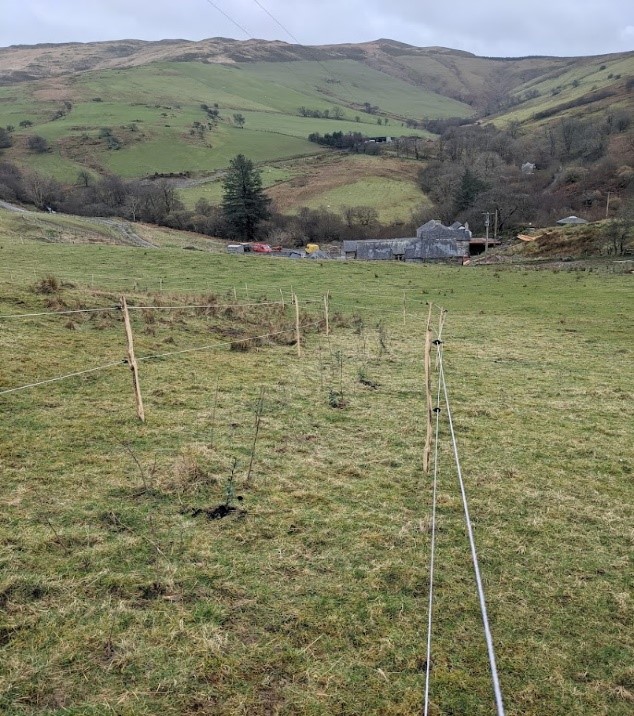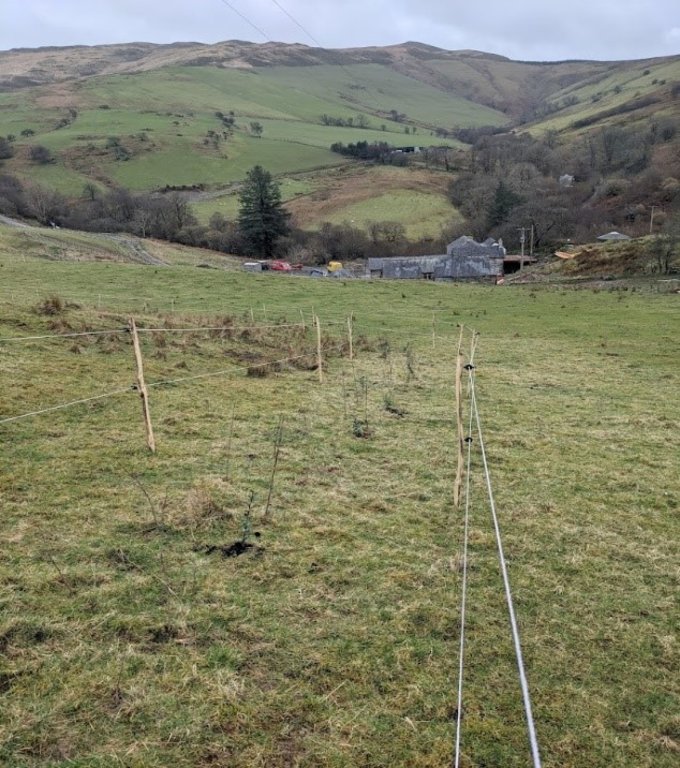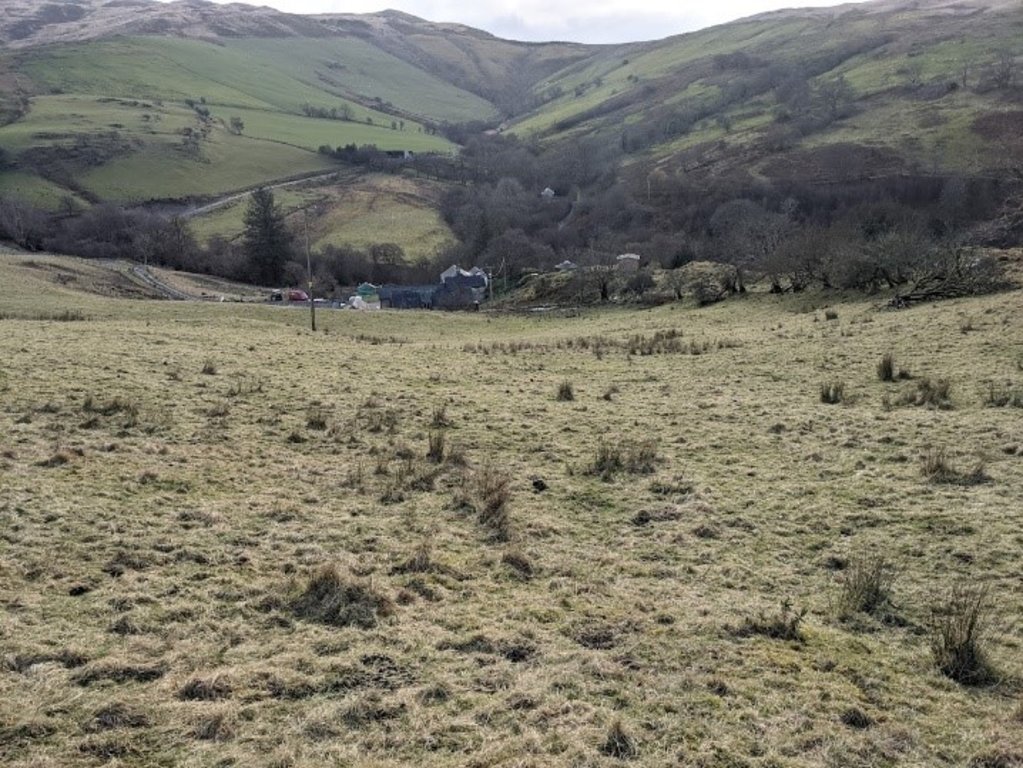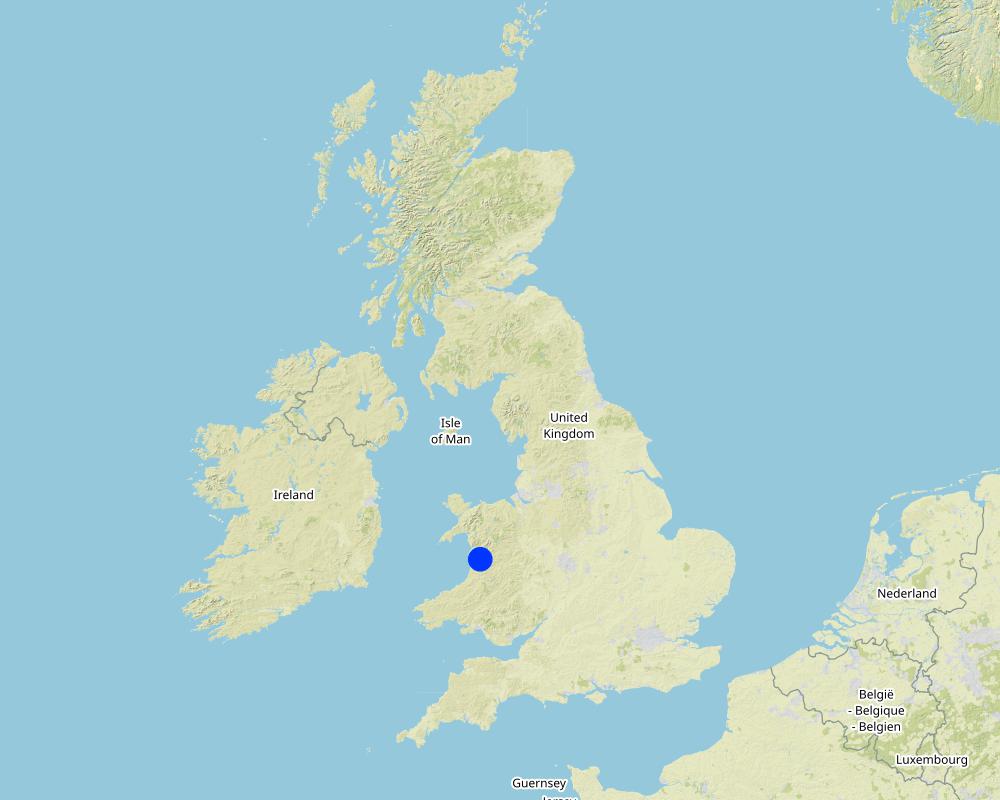Silvopastoral Agroforestry with Cattle [United Kingdom]
- Creation:
- Update:
- Compiler: Alan Radbourne
- Editor: –
- Reviewers: William Critchley, Rima Mekdaschi Studer
technologies_6347 - United Kingdom
View sections
Expand all Collapse all1. General information
1.2 Contact details of resource persons and institutions involved in the assessment and documentation of the Technology
Key resource person(s)
co-compiler:
Fisher Karen
Soil Association
land user:
Hope Joe
Cefn Coch
Name of project which facilitated the documentation/ evaluation of the Technology (if relevant)
European Interreg project FABulous FarmersName of the institution(s) which facilitated the documentation/ evaluation of the Technology (if relevant)
UK Centre for Ecology & Hydrology (CEH) - United Kingdom1.3 Conditions regarding the use of data documented through WOCAT
The compiler and key resource person(s) accept the conditions regarding the use of data documented through WOCAT:
Ja
1.4 Declaration on sustainability of the described Technology
Is the Technology described here problematic with regard to land degradation, so that it cannot be declared a sustainable land management technology?
Nee
2. Description of the SLM Technology
2.1 Short description of the Technology
Definition of the Technology:
A mixture of silvopastoral agroforestry approaches, including extensive and rotational cattle grazing around trees, provide benefits for biodiversity as well as leaf fodder for cattle, edible fruits and nuts, and wood fuel.
2.2 Detailed description of the Technology
Description:
A first generation farmer with a mixed 36 hectare farm has been exploring the establishment of a regenerative silvopastoral agroforestry system.
Under this system the farm has been divided into four zones:
1. Cae mawr- 4.3 ha field. Formerly semi-improved permanent pasture with occasional scattered trees. The field has been divided with hedges into 8 rotational grazing units for Highland and Welsh White cattle. Hedges are of mixed edible fruit and nut varieties. The more distant hedges are composed of mixed native species.
2. Cae Ceirch – 5.4 ha field. Semi-improved permanent pasture with scattered trees and gorse bush. New planting of native species amongst the gorse, creating enclosures by planting native trees at a variety of densities. Electric fences have installed for protection and will be removed once the trees are large enough to withstand browsing. Additionally, field trees are being planted and protected with "cactus tree guards" (tubular sleeves of wire mesh with outer spikes).
3. Lower slopes - 3 ha area. Old pasture which has been grazed exceptionally lightly for a number of years. Allowing native trees, mostly birch, willow and hazel to naturally regenerate. Bracken and bramble have been controlled by pigs with the aim of rehabilitating towards a silvopastoral system. Some thinning of trees will be undertaken in places to achieve that end.
4. Riparian woodland - 1 ha area. Occasionally grazed by cattle on an "as needed" (ad hoc) basis.
The system aims to produce high quality nutrient-dense food, with the highest animal welfare, whilst simultaneously providing maximum biodiversity benefits.
New tree planting is protected by electric fencing comprising chestnut posts with ring insulators and poly wire, with cactus tree guards for individual trees.
The benefits include shelter and shade for animals, with increased diversity of forage. In time there will be a harvest of edible products for human consumption (fruits and nuts etc). And the system provides a variety of biodiversity benefits as well as a visual - aesthetic - improvement to the landscape.
2.3 Photos of the Technology
2.5 Country/ region/ locations where the Technology has been applied and which are covered by this assessment
Country:
United Kingdom
Region/ State/ Province:
Wales
Further specification of location:
Machynlleth
Specify the spread of the Technology:
- applied at specific points/ concentrated on a small area
Is/are the technology site(s) located in a permanently protected area?
Nee
Comments:
Cefn Coch, Glaspwll, Machynlleth, SY20 8UA
Map
×2.6 Date of implementation
Indicate year of implementation:
2018
2.7 Introduction of the Technology
Specify how the Technology was introduced:
- through land users' innovation
3. Classification of the SLM Technology
3.1 Main purpose(s) of the Technology
- improve production
- conserve ecosystem
- preserve/ improve biodiversity
- adapt to climate change/ extremes and its impacts
- Improve animal welfare
3.2 Current land use type(s) where the Technology is applied
Land use mixed within the same land unit:
Ja
Specify mixed land use (crops/ grazing/ trees):
- Agro-silvopastoralism

Grazing land
Intensive grazing/ fodder production:
- Improved pastures
Animal type:
- cattle - non-dairy beef
Is integrated crop-livestock management practiced?
Nee
Products and services:
- meat
Species:
cattle - non-dairy beef
Count:
15
Species:
swine
Count:
5

Forest/ woodlands
- Tree plantation, afforestation
Tree plantation, afforestation: Specify origin and composition of species:
- Mixed varieties
Type of tree plantation, afforestation:
- temperate continental forest plantation
Are the trees specified above deciduous or evergreen?
- deciduous
Products and services:
- Fuelwood
- Fruits and nuts
- Grazing/ browsing
- Nature conservation/ protection
- Recreation/ tourism
3.3 Has land use changed due to the implementation of the Technology?
Has land use changed due to the implementation of the Technology?
- No (Continue with question 3.4)
Land use mixed within the same land unit:
Ja
Specify mixed land use (crops/ grazing/ trees):
- Silvo-pastoralism

Grazing land
Intensive grazing/ fodder production:
- Improved pastures
Animal type:
- cattle - non-dairy beef
Is integrated crop-livestock management practiced?
Nee
Products and services:
- meat
Species:
cattle - non-dairy beef
Count:
15
Species:
swine
Count:
5

Forest/ woodlands
- Tree plantation, afforestation
Tree plantation, afforestation: Specify origin and composition of species:
- Mixed varieties
Type of tree plantation, afforestation:
- temperate continental forest plantation
Are the trees specified above deciduous or evergreen?
- deciduous
Products and services:
- Fuelwood
- Fruits and nuts
- Grazing/ browsing
- Nature conservation/ protection
- Recreation/ tourism
3.4 Water supply
Water supply for the land on which the Technology is applied:
- rainfed
3.5 SLM group to which the Technology belongs
- agroforestry
- windbreak/ shelterbelt
- pastoralism and grazing land management
3.6 SLM measures comprising the Technology

vegetative measures
- V1: Tree and shrub cover

management measures
- M1: Change of land use type
- M2: Change of management/ intensity level
3.7 Main types of land degradation addressed by the Technology

soil erosion by water
- Wt: loss of topsoil/ surface erosion

biological degradation
- Bc: reduction of vegetation cover
- Bh: loss of habitats
3.8 Prevention, reduction, or restoration of land degradation
Specify the goal of the Technology with regard to land degradation:
- restore/ rehabilitate severely degraded land
4. Technical specifications, implementation activities, inputs, and costs
4.2 General information regarding the calculation of inputs and costs
Specify how costs and inputs were calculated:
- per Technology area
Indicate size and area unit:
40 hectares
If using a local area unit, indicate conversion factor to one hectare (e.g. 1 ha = 2.47 acres): 1 ha =:
1 ha = 2.47 acres
other/ national currency (specify):
£GBP
If relevant, indicate exchange rate from USD to local currency (e.g. 1 USD = 79.9 Brazilian Real): 1 USD =:
0.85
Indicate average wage cost of hired labour per day:
£150
4.3 Establishment activities
| Activity | Timing (season) | |
|---|---|---|
| 1. | Ground preparation – marking out planting lines | Winter |
| 2. | Planting trees | Winter |
| 3. | Erecting electric fencing | Winter |
4.4 Costs and inputs needed for establishment
If you are unable to break down the costs in the table above, give an estimation of the total costs of establishing the Technology:
8000.0
If land user bore less than 100% of costs, indicate who covered the remaining costs:
100%
4.5 Maintenance/ recurrent activities
| Activity | Timing/ frequency | |
|---|---|---|
| 1. | Checking trees visually | Ongoing - monthly |
| 2. | Vegetation maintaince via mowing | Once a year in late summer |
| 3. | Management of rotational mob grazing | Ongoing during grazing season - daily |
| 4. | Checking electric fences | Ongoing - weekly |
4.6 Costs and inputs needed for maintenance/ recurrent activities (per year)
| Specify input | Unit | Quantity | Costs per Unit | Total costs per input | % of costs borne by land users | |
|---|---|---|---|---|---|---|
| Labour | Checking trees & electric fences | Hours | 24.0 | 10.0 | 240.0 | 100.0 |
| Labour | Vegetation maintance | Hours | 30.0 | 10.0 | 300.0 | 100.0 |
| Labour | Management of rotational grazing pastures | Hours | 100.0 | 10.0 | 1000.0 | 100.0 |
| Equipment | Flail mower attachment to tractor / strimmer | unit | 1.0 | 100.0 | ||
| Total costs for maintenance of the Technology | 1540.0 | |||||
| Total costs for maintenance of the Technology in USD | 1811.76 | |||||
Comments:
Flail mower attachment to tractor / strimmer already owned as part of farm management
4.7 Most important factors affecting the costs
Describe the most determinate factors affecting the costs:
The cost of trees, establishment (i.e. planting & replacing trees) and fencing
5. Natural and human environment
5.1 Climate
Annual rainfall
- < 250 mm
- 251-500 mm
- 501-750 mm
- 751-1,000 mm
- 1,001-1,500 mm
- 1,501-2,000 mm
- 2,001-3,000 mm
- 3,001-4,000 mm
- > 4,000 mm
Agro-climatic zone
- humid
5.2 Topography
Slopes on average:
- flat (0-2%)
- gentle (3-5%)
- moderate (6-10%)
- rolling (11-15%)
- hilly (16-30%)
- steep (31-60%)
- very steep (>60%)
Landforms:
- plateau/plains
- ridges
- mountain slopes
- hill slopes
- footslopes
- valley floors
Altitudinal zone:
- 0-100 m a.s.l.
- 101-500 m a.s.l.
- 501-1,000 m a.s.l.
- 1,001-1,500 m a.s.l.
- 1,501-2,000 m a.s.l.
- 2,001-2,500 m a.s.l.
- 2,501-3,000 m a.s.l.
- 3,001-4,000 m a.s.l.
- > 4,000 m a.s.l.
Indicate if the Technology is specifically applied in:
- not relevant
5.3 Soils
Soil depth on average:
- very shallow (0-20 cm)
- shallow (21-50 cm)
- moderately deep (51-80 cm)
- deep (81-120 cm)
- very deep (> 120 cm)
Soil texture (topsoil):
- medium (loamy, silty)
Soil texture (> 20 cm below surface):
- medium (loamy, silty)
Topsoil organic matter:
- high (>3%)
5.4 Water availability and quality
Ground water table:
< 5 m
Availability of surface water:
good
Water quality (untreated):
poor drinking water (treatment required)
Water quality refers to:
ground water
Is water salinity a problem?
Nee
Is flooding of the area occurring?
Nee
5.5 Biodiversity
Species diversity:
- medium
Habitat diversity:
- medium
5.6 Characteristics of land users applying the Technology
Sedentary or nomadic:
- Sedentary
Market orientation of production system:
- mixed (subsistence/ commercial)
Off-farm income:
- > 50% of all income
Relative level of wealth:
- average
Individuals or groups:
- individual/ household
Level of mechanization:
- mechanized/ motorized
Gender:
- men
Age of land users:
- middle-aged
5.7 Average area of land used by land users applying the Technology
- < 0.5 ha
- 0.5-1 ha
- 1-2 ha
- 2-5 ha
- 5-15 ha
- 15-50 ha
- 50-100 ha
- 100-500 ha
- 500-1,000 ha
- 1,000-10,000 ha
- > 10,000 ha
Is this considered small-, medium- or large-scale (referring to local context)?
- small-scale
5.8 Land ownership, land use rights, and water use rights
Land ownership:
- individual, not titled
Land use rights:
- individual
Water use rights:
- individual
Are land use rights based on a traditional legal system?
Nee
5.9 Access to services and infrastructure
health:
- poor
- moderate
- good
education:
- poor
- moderate
- good
technical assistance:
- poor
- moderate
- good
employment (e.g. off-farm):
- poor
- moderate
- good
markets:
- poor
- moderate
- good
energy:
- poor
- moderate
- good
roads and transport:
- poor
- moderate
- good
drinking water and sanitation:
- poor
- moderate
- good
financial services:
- poor
- moderate
- good
6. Impacts and concluding statements
6.1 On-site impacts the Technology has shown
Socio-economic impacts
Production
fodder production
Comments/ specify:
Increased diversity with new tree forage available
animal production
Comments/ specify:
Improved welfare for cattle as trees provide shelter.
forest/ woodland quality
Comments/ specify:
Increased forest areas, diversity and connectivity
product diversity
Comments/ specify:
Trees provide wood fuel, fruit and nuts, alongside possible future option for recreation and tourism opportunities
Income and costs
diversity of income sources
Comments/ specify:
Trees provide wood fuel, fruit and nuts, alongside possible future option for recreation and tourism opportunities
workload
Comments/ specify:
Time for installation and management is higher than previous
Socio-cultural impacts
Aesthetic appeal of landscape - i.e. landscape looks better
Comments/ specify:
More trees in the fields and flowering hedgerows etc
Ecological impacts
Soil
soil organic matter/ below ground C
Comments/ specify:
Trees as stores of carbon and improved soil health
Biodiversity: vegetation, animals
biomass/ above ground C
Comments/ specify:
Addition of above ground biomass in trees and hedgerows
plant diversity
Comments/ specify:
More diversity of productive and native trees and hedges
habitat diversity
Comments/ specify:
More space for biodiversity
6.3 Exposure and sensitivity of the Technology to gradual climate change and climate-related extremes/ disasters (as perceived by land users)
Gradual climate change
Gradual climate change
| Season | increase or decrease | How does the Technology cope with it? | |
|---|---|---|---|
| annual temperature | increase | well |
6.4 Cost-benefit analysis
How do the benefits compare with the establishment costs (from land users’ perspective)?
Short-term returns:
slightly negative
Long-term returns:
positive
How do the benefits compare with the maintenance/ recurrent costs (from land users' perspective)?
Short-term returns:
slightly negative
Long-term returns:
positive
6.5 Adoption of the Technology
- single cases/ experimental
Of all those who have adopted the Technology, how many did so spontaneously, i.e. without receiving any material incentives/ payments?
- 91-100%
6.6 Adaptation
Has the Technology been modified recently to adapt to changing conditions?
Nee
6.7 Strengths/ advantages/ opportunities of the Technology
| Strengths/ advantages/ opportunities in the land user’s view |
|---|
| Offers the opportunity to radically increase the biodiversity potential of the farm |
| Shelter belts improve animal welfare |
| Productivity increases with diversification of products and co-benefits. |
| Strengths/ advantages/ opportunities in the compiler’s or other key resource person’s view |
|---|
| A whole system approach promotes co-benefits of the farm improving animal welfare, biodiversity and diversification and thus resilience of the farm business. |
6.8 Weaknesses/ disadvantages/ risks of the Technology and ways of overcoming them
| Weaknesses/ disadvantages/ risks in the land user’s view | How can they be overcome? |
|---|---|
| High set up costs | Careful choice of tree protection mechanism and seeking grant assistance |
| Weaknesses/ disadvantages/ risks in the compiler’s or other key resource person’s view | How can they be overcome? |
|---|---|
| The system can be expensive to implement for little return in short-term | Grant assistance |
| Approach takes time to implement (i.e. trees to grow) before full benefits are seen, and management during this time in particular is higher than traditional methods | Long-term farm planning and seek guidance for the most effective implementation techniques to ensure best chance of success |
7. References and links
7.1 Methods/ sources of information
- field visits, field surveys
Multiple farm visits by SLM specialist in support of implementation
- interviews with land users
Formal interview with farmer to gather required information and experiences to share learnings
When were the data compiled (in the field)?
15/11/2021
7.4 General comments
The implementation of this silvopastoral agroforestry system is still in its relatively early stages as the trees and hedges have not yet reached maturity and thus the land user has not seen the full benefits of the work undertaken. However, in this whole-system approach to long term regeneration of the farm the land user has been able to plan well and utilise expertise and experience to make it a success.
Links and modules
Expand all Collapse allLinks
No links
Modules
No modules





